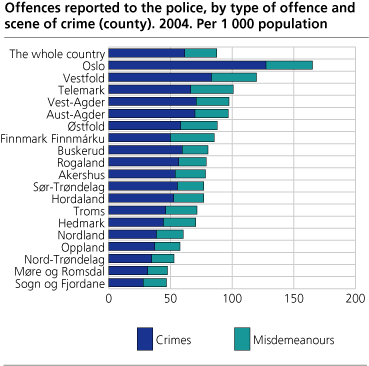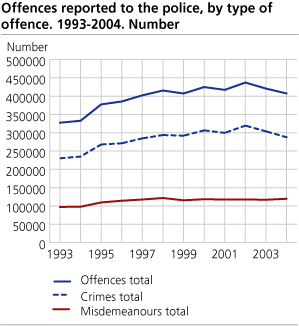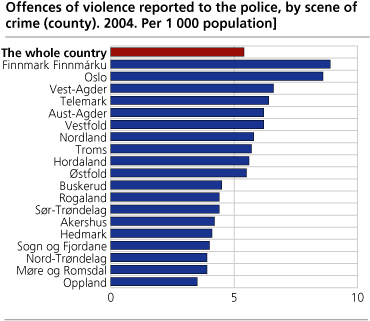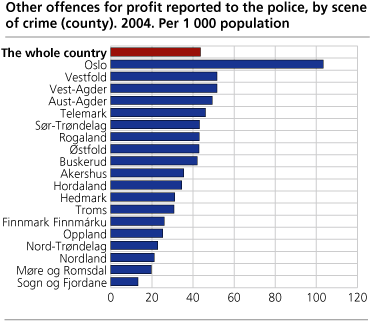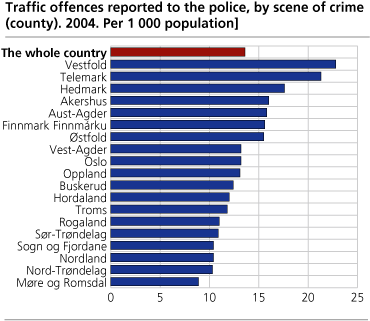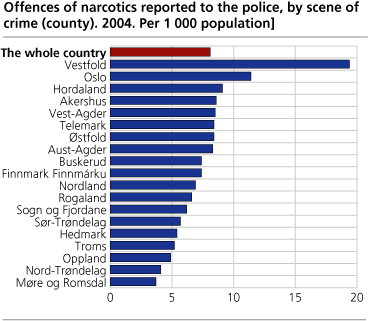Content
Published:
This is an archived release.
Geographic variations in crime
407 000 offences were reported to the police in Norway in 2004, the lowest number since 1999. Overall, most offences reported to the police were committed in Oslo. However, relative to the population a lot more narcotic crimes were reported to the police in Vestfold. Of all offences reported to the police last year, most incidents of violence offences were committed in Finnmark, relative to population.
|
SSB crime statistics on offences reported to the police 1993-2004
Statistics on offences reported to the police was recently revised for the period 1993-2002, and now followed up by new statistics for 2003 and 2004 (ref. publications in the period April-June 2005). SSB has changed the routines for preceding the data from the police, and the changes made, imply among other things, higher quality and better comparability over time. Up till now, complete county statistics for the period 1993-2000 has not been published. These will be published later, in order to make the official crime statistics on offences reported to the police complete for the whole period. However, no plan exists however, to publish revised statistics by police district for the same period, due to lack of comparability between new and old districts. (See also About the statistics ). |
On national basis, offences reported to the police decreased by 3,2 per cent compared to the previous year. There were 5,3 per cent less crimes and 2,2 per cent more misdemeanours reported to the police. The total number of offences reported to the police is the lowest since 1999, and the extent of crimes is the lowest since 1997. The extent of economic offences is back to normal level after one big incident of fraud in 2003, and this contributed to half the decrease in number of crimes. It is crimes inflicting damage to property (down by 5,9 per cent) and not least offences for profit (down by 4,1), which contribute most to the reduction from 2003 to 2004.
The increase in number of misdemeanours has, first and foremost, connection with more reported traffic offences: 62 600 traffic offences were reported in 2004, the highest number since 1993. Last year's increase of 5 per cent is due to cases related to illegal speeding, which rose by 22 per cent from 2003 to 2004. In the period 1995-2002 the number of ticket fines caused by illegal speeding (less serious misdemeanours leading to on the spot fines are not included in the statistics) was relatively stable around the yearly average of 9 300. During the last two years this is more than doubled, mainly because of the increase in the number registered by automatic traffic control.
Less aggravated larcenies
The decline in theft from automobiles, domestic and dwelling burglaries explain most of the reduction in the total number of offences for profit from 2003 to 2004. The total number of aggravated larcenies fell by 6 per cent (from 68 400 to 64 400) - and is now back to 2001-level. Aggravated larcenies from dwellings fell by 18 per cent, with a particular big decrease in number of larcenies from holiday homes.
Aggravated larcenies from cars and other means of transport decreased by 10 per cent from 2003 to 2004. In addition, theft of motor vehicles decreased by 11 per cent, where cars were reduced with 15 per cent. During 2004, 19 100 aggravated larcenies from -and 17 900 larcenies with the purpose of use of -motor vehicles were reported to the police. Both these types of larcenies are mainly related to automobiles, and are the lowest numbers reported in the 12-year history of the statistics.
No further decrease in narcotic offences
After two years decrease in reported offences of use and possession of narcotics, the total number of narcotic offences in 2004 equals the number in 2003. Still this number is almost 20 per cent lower than in 2001, when more than 15 per cent of all offences reported to the police were related to narcotic offences. This share was reduced to 13 per cent in 2004.
Great regional variation in scene of crime
Looking at scenes of crime, we find relative large differences from one county to another. For instance, the number of reported offences committed in Oslo was 17 times larger than the number of offences committed in Sogn and Fjordane. Relative to the population in the counties, there are substantial geographical variations in what group of offence that are reported to the police.
The county Oslo has the highest number of offences for profit, almost three times more than the average for all counties (respectively 103 and 39 per 1 000 population).
Relative to population, offences of violence are mostly committed in Oslo and Finnmark.
Contact
-
Reid Jone Stene
E-mail: reid.jone.stene@ssb.no
tel.: (+47) 99 02 22 01
-
Siri Fjærtoft Fossanger
E-mail: siri.fossanger@ssb.no
tel.: (+47) 99 72 49 27

